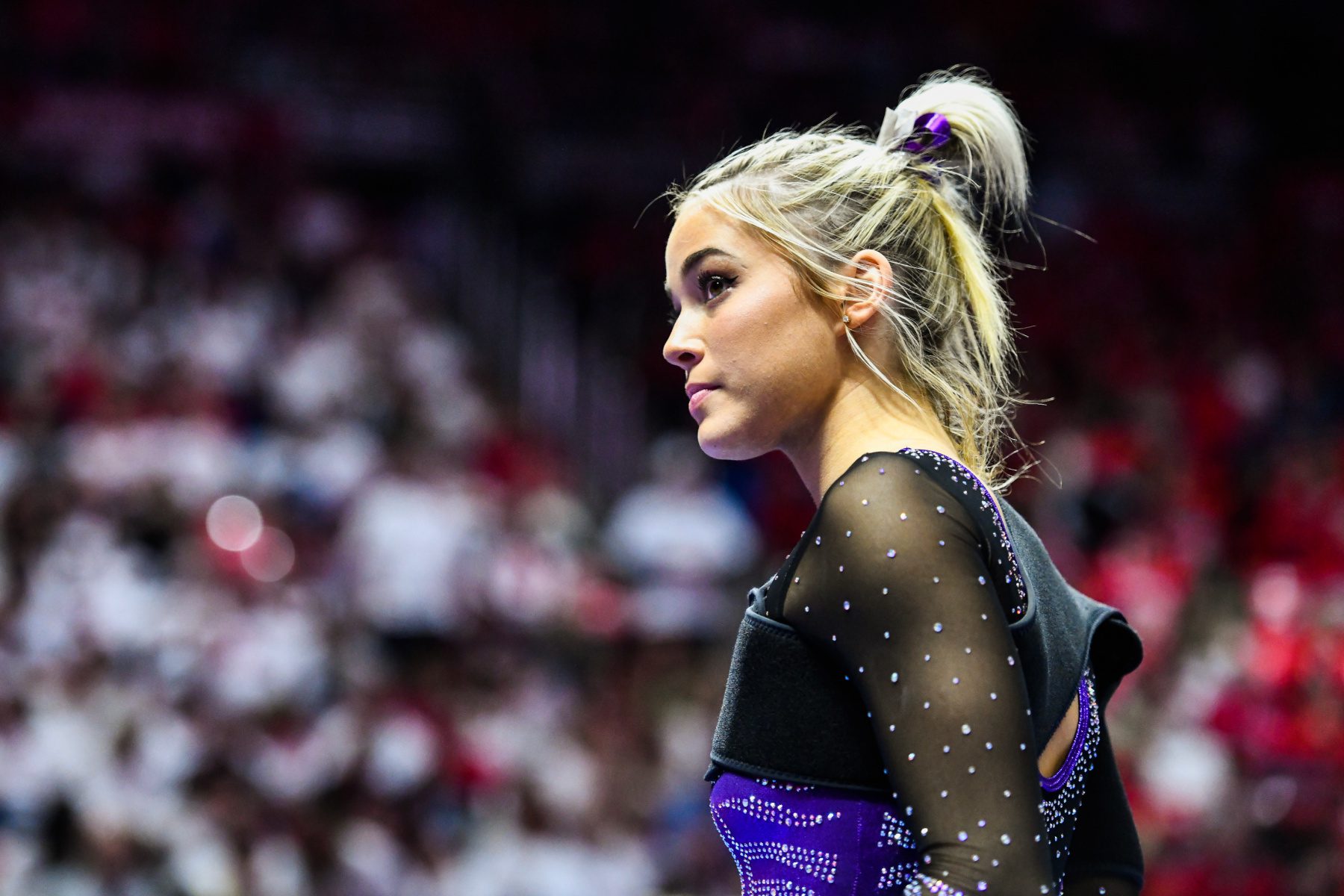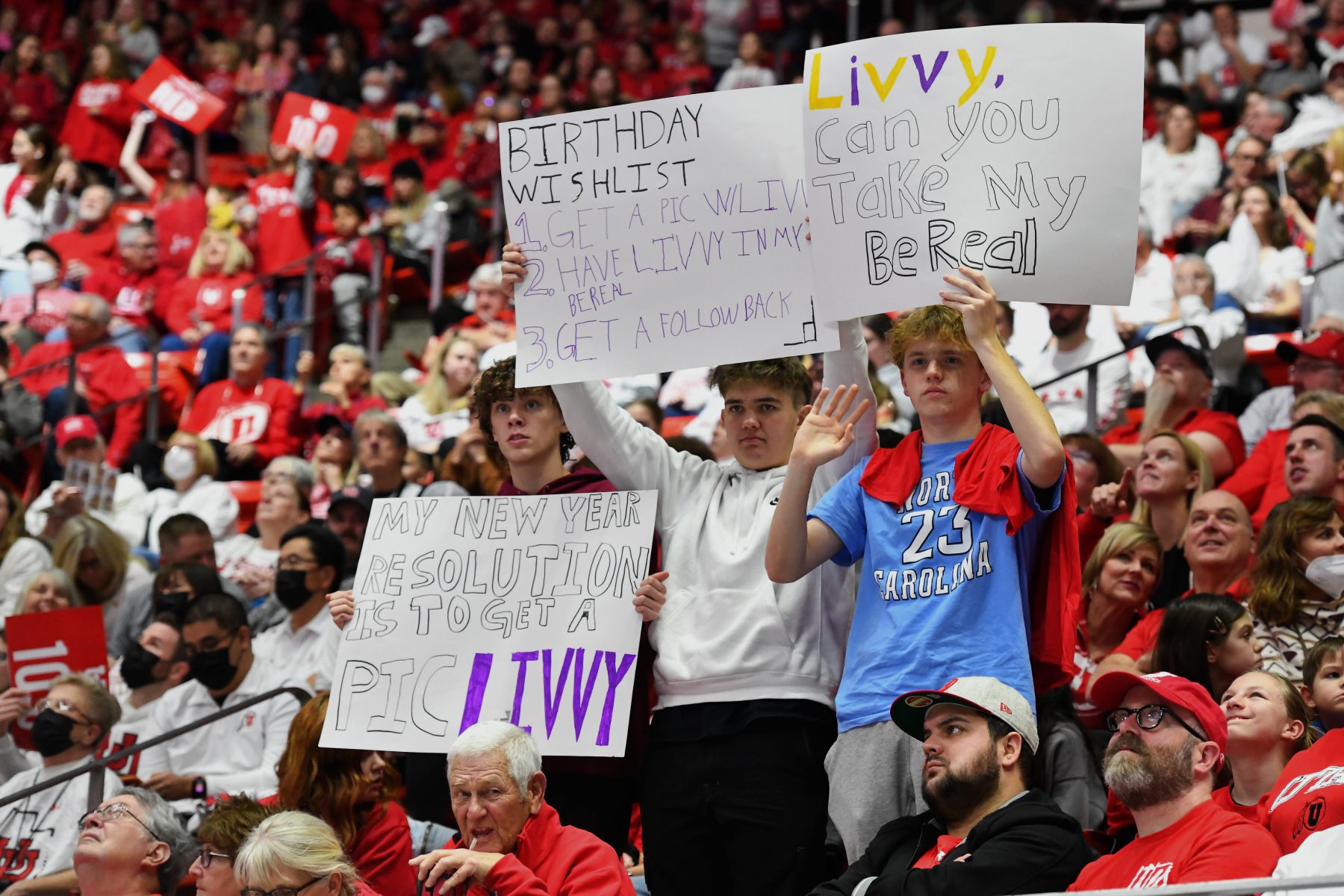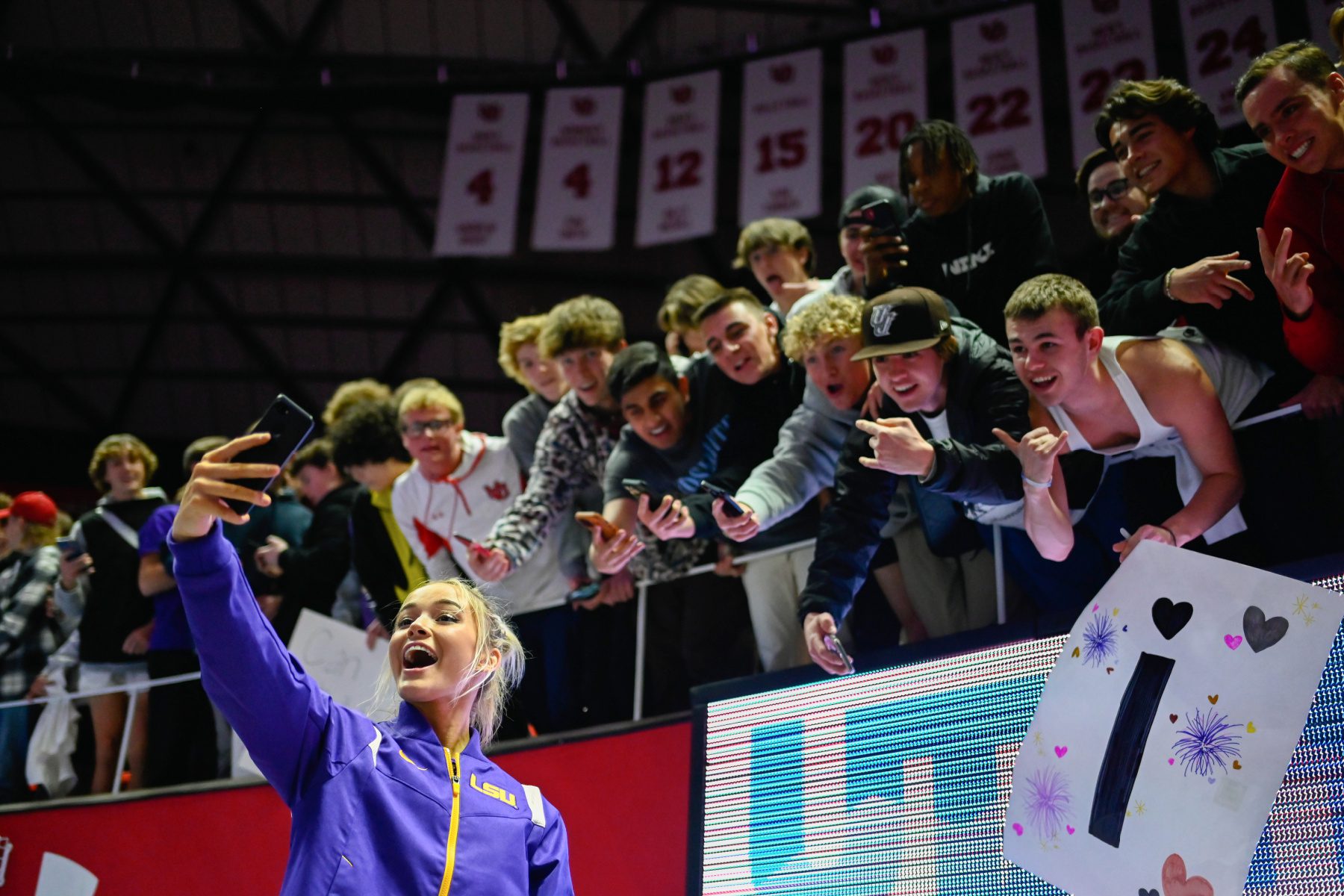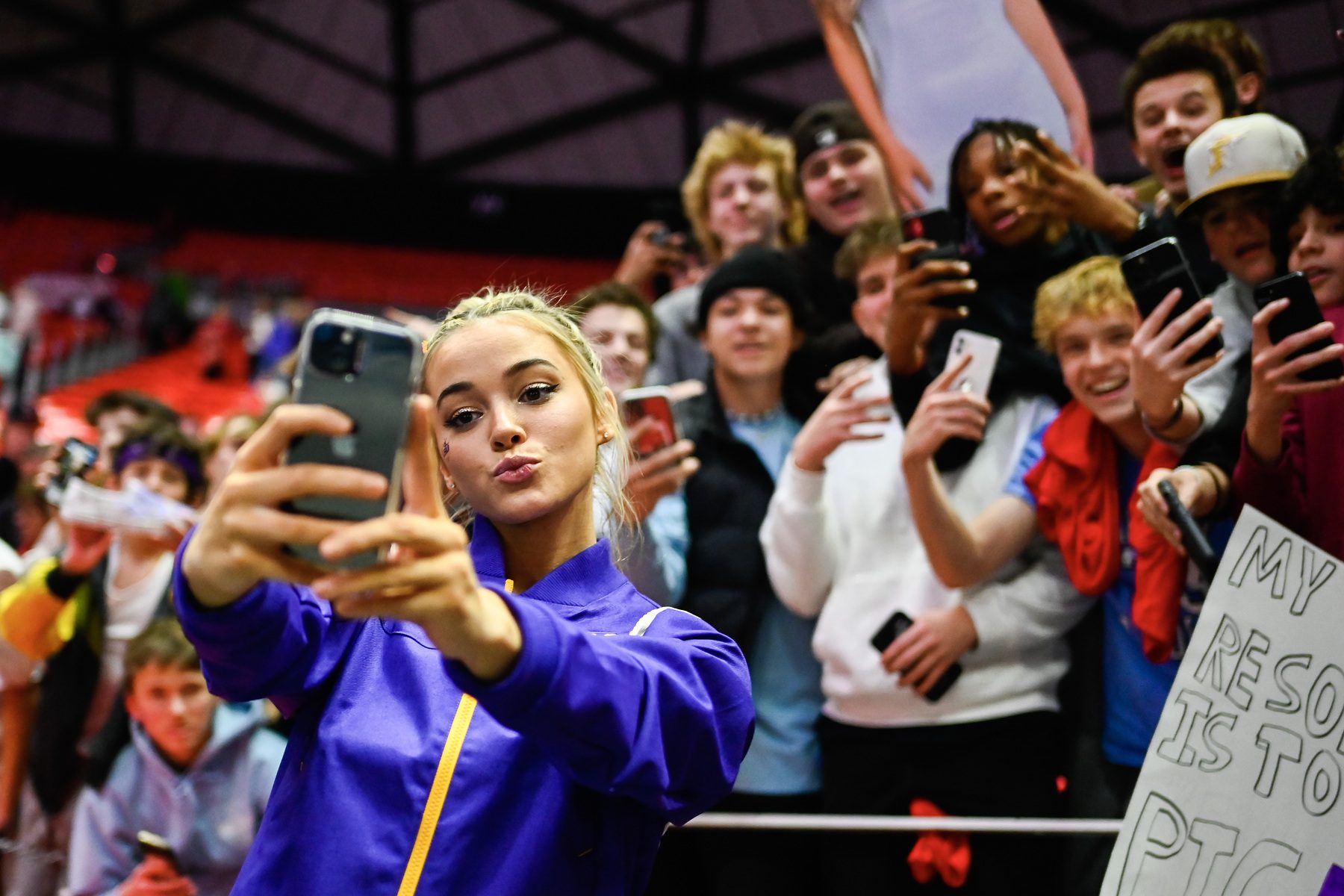We’re telling the untold stories of women, women of color and LGBTQ+ people. Subscribe to our daily newsletter.
Olivia Dunne has 6.7 million followers on TikTok and 2.8 million followers on Instagram. But on a recent Sunday, the 20-year-old wasn’t dropping new content onto her social platforms. She was doing what first brought her into social media fame: competing at a gymnastics meet with her Louisiana State University (LSU) teammates.
Outside the Jon M. Huntsman Center in Salt Lake City, where LSU was competing against the University of Utah, hundreds of teenage boys surrounded the doors and LSU’s team bus, screaming “Livvy!” and saying they wouldn’t move until they saw the student-athlete and social media star in person. Ultimately, LSU had to move its bus, and the police had to step in to ensure athletes from both teams could exit the meet safely.
Later that day, Dunne tweeted to her 54,400 Twitter followers, “I will always appreciate and love the support from you guys, but if you come to a meet, I want to ask you to please be respectful of the other gymnasts and the gymnastics community as we are just doing our job.” LSU announced several days after the meet that it would increase security for the gymnastics team at all competitions.
Dunne is the most-followed college athlete on all of social media. Her NIL — or name, image and likeness, the term for the way in which a college athlete may monetize and publicize their personal brand through endorsements, sponsorship and ad deals — is said to be valued at $2.7 million, and she is the only woman student athlete in the top 10 NIL values in college sports. The other nine are all men’s basketball and football players.
Student-athletes have been allowed by the National College Athletics Association (NCAA) to be compensated for their NIL only since July of 2021. The NIL policy came about after years of increased attention to the fact that college athletes are not allowed to be paid by their college or university for their work on a school team — even though schools, especially those with popular men’s athletics programs, can generate huge profits off their performance.
But as the situation with Dunne revealed, the NIL policy has created a kind of double-edged sword for women student-athletes, allowing them to financially benefit in a way they otherwise never could from their sport, but also making them vulnerable to the dark side of online fandom. If parasocial relationships — or the belief by a media consumer that they are friends with a media personality despite limited or no first-hand interactions with them — are making it possible for women student athletes to reap new financial rewards, they’re also making them newly vulnerable to fans who increasingly feel entitled to their presence 24/7, on their screen and in real life. And schools are for the most part not prepared to deal with this new attention and the risks that come with it.

Molly Yanity, an associate professor of journalism at Quinnipiac University and an expert on college sports, gender and media, said Dunne represents a kind of “perfect storm” that is created by the “financial investment of fans in college sports, the investment of time and passion into fans in college sports, and the sexualization of females in the entertainment business.” The situation also speaks to the disparities that exist between the ways schools choose to invest in their men’s and women’s sports programs, she said.
Universities, Yanity said, “want the good athletes on their field and I don’t think the safety of female athletes has ever crossed their mind” in navigating the implementation of the NIL policy. The NIL incentivizes men athletes to stay on a college team longer before going pro, but fails to account for the ways women athletes who don’t have the option of a professional career are positioned to capitalize on their NIL opportunities when being an influencer might be their most profitable future career track.
The fact that schools do not pay student-athletes for their labor is part of the fundamental problem, she said. But the NIL policy also ignores “the realities of how the sexualization of female athletes plays into this.”
The policy, she said, has inadvertently created a situation where female athletes aren’t necessarily being rewarded for their performance in their sport, but for performing conventional beauty standards on social media platforms. But paradoxically, women athletes’ social media presence is critical to their ability to build a fan base and draw attention to their athletic capabilities.
“An individual’s social media presence is the number one way female athletes can connect with fans and sponsors because they’re not on TV as much,” Yanity said. “Other than the SEC Network and ESPN U, I’ve never seen college gymnastics aired on TV. If athletes want to make money — which of course they want to — they have to take their message and photos to social media and there’s nothing wrong with that. We want them to feel empowered to do that. But because of what our society values, a gorgeous young woman is going to be the envy of young men and that’s where the financial power will lie.”
But while women athletes who present themselves according to current beauty standards stand to earn the most, they also face backlash for doing just that, Yannity said. Since the incident in Utah, Yanity said she’s seen numerous media outlets imply that Dunne “brings this on herself.”
“Why does that have to be the narrative?” Yanity asked. “She can do whatever she wants. Should she give up her over 2 million dollars? Hell no. She deserves the ability to monetize her ability and her looks. All the power to her.”
But the reality remains, Yanity said, to be a young, conventionally beautiful woman online and in sports means accepting “backlash” as a norm — and colleges and universities could do more to help support athletes through this with sports psychologists on hand to help navigate this new reality. Colleges and universities should also take the initiative, she said, to provide more security for women athletes at competitions in this context. “This incident took LSU and Utah by surprise and I empathize in a way — how do you say, ‘Well if you want to do NIL, be ready for men who can’t control themselves?’”
But Yanity said she is also concerned about the young women who will look at Dunne’s tremendous NIL success and try to attain that for themselves by pursuing athletics. It’s already happening, she’s saying, with more and more young athletes starting even in middle school trying to develop personal brands for themselves through social media. “Will they get a scholarship? Will they burn out at 13 years old? Especially if things evolve and the pro leagues eventually start subsidizing men’s college sports — what happens under Title IX? Women’s sports will be swept aside once again.”
Kathyrn Coduto, an assistant professor of media science at Boston University who studies social media and its effects on interpersonal relationships, said that the compulsive way many people engage with social media, constantly checking for updates and new content, has intensified parasocial relationships into something new and perhaps more dangerous.
“When you’re constantly on your phone, even if you haven’t met someone, if you constantly see them on your screen they feel like your friend — and someone you should have access to all the time, too.”

Gender, she said, plays a crucial and sometimes dangerous role in this feeling many social media users that they are owed guaranteed, round-the-clock access. “The stereotype exists that women are influencers and if they are influencers then they want people looking at them all the time and that the people they want looking at them are men.”
While this stereotype is pervasive, and dangerous, on its merits for any influencer, Coduto said it can be even more so for a student-athlete like Dunne. “A college gymnast is someone who is trying to do a job and compete in her sport. It’s not about who is looking at her — that’s not the priority. But there’s this belief that she must deserve this because she created this high profile for herself.”
Women athletes, said Coduto, are often forgotten in conversations about NIL, which instead focus on the ability of men college football players and their ability to make money for playing in programs that reap financial rewards for their performance. But women athletes deserve the same right to compensation, Coduto said. “They should be able to earn money and their being successful with NIL does raise a lot of capital for their programs — but the trade-off is that they themselves are not for sale. People get confused about that. Olivia Dunne is not selling her body or access to herself.”
Women, and women athletes in the wake of NIL, face difficult societal expectations, said Coduto. “For women there is this expectation that you should be good at social media and you should know how to handle it. A lot of college athletes are learning and seeing people like Olivia Dunne — and they understand that she might be giving access to herself through promoting products, but that’s not the same as being available for anyone to consume whenever they want.”
From her research, Coduto said she has seen that part of what drives people to be constantly online is the hope that an influencer may have liked a comment of theirs, in turn prompting people to engage even more with influencers. And many people believe that a comment or reply back constitutes a real relationship. “For creators, their online presence is a brand. For an athlete, they are creating a brand. If you’re following someone on Instagram or TikTok, you’re getting a filtered version of that person and not a real person. People seem to forget this.”
Many high-profile influencers have a team managing their accounts, meaning they’re not even responding to or liking comments personally — though many users do not realize this. “This translates to in-person behaviors,” said Coduto. “Maybe she likes my comment — so why can’t I see her in person and take a photo? You’re thinking you know this person because you can see them online and if you can get a photo, it will make it real to all the people who follow you. People are thinking about their own followings in addition to the people they follow, and it creates this vicious cycle.”
It’s a cycle that can create a transactional, and dangerous, situation for creators — all the more so when that creator is also a college student and athlete who publicly competes. “When you see how willing people are to show up in person just to objectify you, that’s dangerous,” Coduto said. “It takes just one truly unwell person to take that from uncomfortable to dangerous, thinking, ‘I have to meet you.’”
Kristin Drogos, a media psychologist at the University of Michigan who studies both parasocial relationships and social contagion as impacted by social media, told The 19th that it’s important to understand the evolution of parasocial relationships in the age of social media. “We had this true separation from ‘person in the media’ and ‘person consuming that media’ — and that separation is now gone. We’re now looking at how people are attaching themselves to social media figures who aren’t playing Rachel Green and Ross Gellar on TV, but people who are showing what is real life for them and they happen to be putting it out on the Internet and social media channels.”
Drogos said that while it is normal for anyone in a parasocial relationship to fantasize about what it might take to make this relationship no longer one-sided, the very nature of social media moves this question out of the realm of fantasy and into that of possibility.
The way gender factors into this cannot be ignored, Drogos said, pointing to situations like Gamergate in 2014 — where women were targeted and severely harassed online by an online-based gaming fan community in response to a larger criticism of some gaming journalists, most of whom were not women, being unethical in their work — that “if you present as female online, you’re going to have aggressive language used against you. It’s not surprising that what happened [with Dunne] started with an online fandom.”

With an attachment formed through the Internet – where sexism and misogyny are openly on display – “it doesn’t seem that far-fetched of an idea that the attitude could then move offline as well when they start entering a real-life group setting and feeding off of one another.”
Social media in general has opened up the possibility for anyone to become an influencer — and benefit from a financial windfall as a result — and the situation is all the more intensified for student-athletes who now both have a built-in platform through their sport and the blessing of the NCAA to build a personal brand and try to profit from it. “There’s a real tightrope to walk when someone is a woman athlete and trying to establish a brand online and having to negotiate all of these dynamics. If we think about how this makes young women accessible, this seeming accessibility is both an opportunity and a risk,” Drogos said.
The situation with Dunne, Drogos said, set a darker tone for a parasocial relationship. “It seemed to be this feeling that they are owed something. ‘She pops up on Twitter, why can’t she pop up in real life? Why can’t she immediately be available to me here?’”
What struck her was the men’s behavior when they realized they could not interact with Dunne. The crowding and harassment at the end of the meet, she said, was far from the overeager friendliness that typically defined parasocial relationships. To her, it carried another message.
“‘You owe me something and why aren’t you here for me?’ That doesn’t feel like friend behavior,” Drogos said. “Do we think women celebrities owe us more than men do? I suspect so.”







